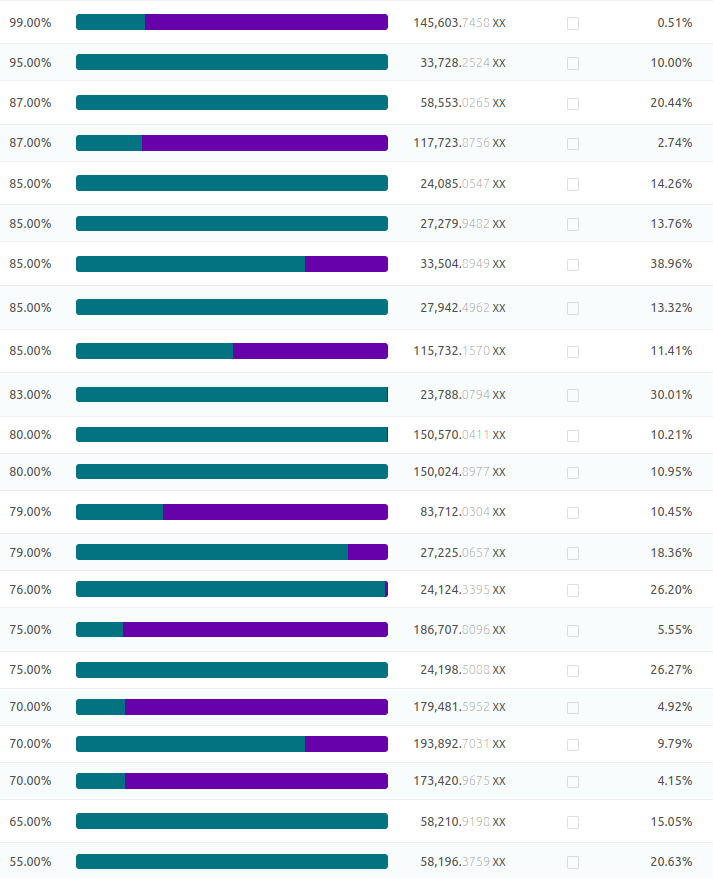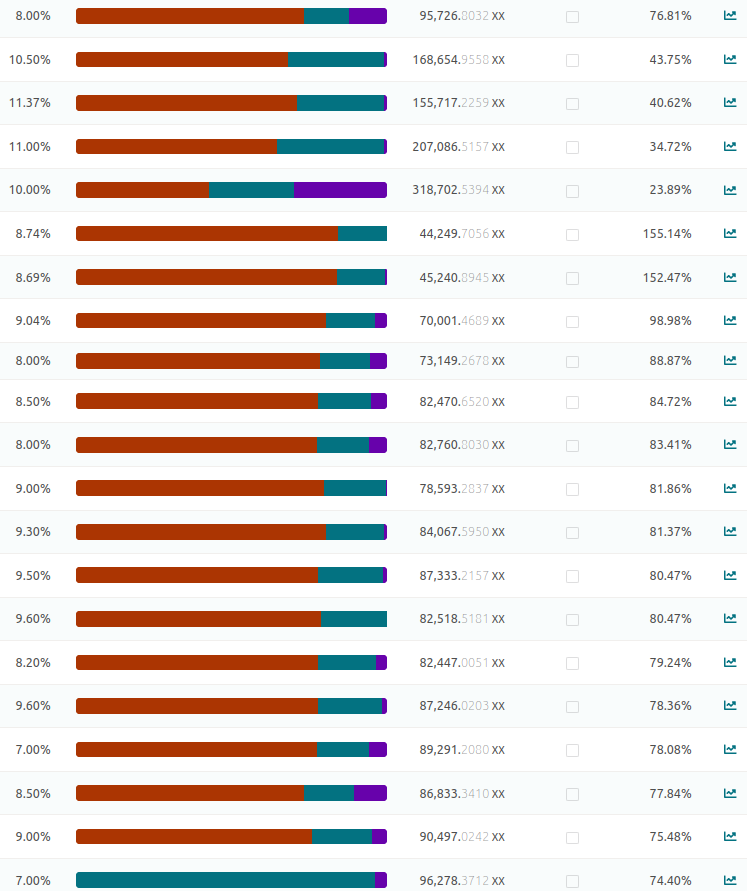I’ve been watching the staking and nomination weirdness on the network for many eras and I can’t resist the urge to make some semi-educated guesses regarding possible reasons.
If you look at the situation - stakes, commissions, nominations - clearly it’s not working as intended.
This post consists of high-level observations about commissions and nominations as it stands now in era 58 (but the same has been true in recent eras).
Let’s take a look at what’s weird about XX Network MainNet:
Weirdness 1 - declining competition ¶
This is the most obvious one - just look at the light (white) line. (Orange is XXV2’s commission (2%), while XXV charges 11% at this time (not shown).)

Does it look like there’s more competition? No, because commissions are growing. Why? We know why, because they can.
Weirdness 2 - brainless nominators ¶
Why would nominators sink 355Kxx on a node that earns 12% a year?

Another example - or rather a bunch of examples - are all these nodes without Team Multiplier. Would you invest in a node that returns 0.51 (see top row in the chart below)%? I don’t think so.

Of course, for the most part nominators aren’t brainless (more on that below). But they can afford to behave like this because of problems affecting incentives.
Weirdness 3 - subsidies promote sloth ¶
This doesn’t surprise me, but in theory at least Team Multiplier was meant to make early validators more competitive.
But of course, subsidies makes them less competitive because they don’t have to compete. If I exclude the ludicrous nodes from the previous screenshot and sort “regular” nodes (which includes Team-backed nodes) by descending validator commission, here’s what we see:

Subsidized nodes charge more than independently operated nodes (if we exclude short-time opportunists).
(My XXV is 4th from the top, by the way. I could charge around 12% and still get a Team Multiplier. You can see it’s got a tiny amount of nominations. I’ve no idea why anyone would want to nominate it for a 23.89% ROI, but some people do that, maybe to spread the risk.)
Why are economic incentives distorted ¶
First, let me make clear - individual players are behaving according to their own interest. But the problem is those incentives should be aligned with the interest of the network and that’s not entirely correct at this moment.
Some of it is due to NPOS, there’s no way to fix it.
But in terms of other issues, here’s why they’re happening (my theory):
- Validator slots are too loosely managed. Short-term opportunists have caused this rise in commission rates and a drop in network quality because validator slots are not tightly managed. There should be some 5-10 validator slots more than the number of team-backed validators, so that validators - including Team-backed validators - must compete to get elected. But now the XX Team allows anyone in, probably with the idea to create sufficient performance for the upcoming boom in XX Messenger traffic. Why this won’t work is what I said above: lack of competition promotes sloth. There’s a crapload of lousy-performing nodes out there now. 10% precomp failure rate? Not a problem, you’ll get re-elected!
- Nodes with very crappy profitability have a ton of nominations because those nominators are the same people as node owners, or run a little DIY staking operation. Some of these people stood up the second (or maybe third, fourth - who the hell knows) node this month. (XXV2 is staked with coins purchased in November). That’s sure allowed, but (see above) many are providing a shitty service for the pay they get.
- Owners of nodes with large validator stakes (including XXV) are candidates for spinning another node once coins can be moved around. Now they can’t, so these validators can choose only one node (their own). Once coins become mobile, competition among nodes will improve but not by a lot - we’re talking about a handful of validators (with less than 1 million xx coins to put elsewhere) compared to many millions that’s been sold.
In an ideal situation validators would make as little as possible (say, $500 per month after expenses).
That means we could have 600 nodes operated by 300 validators, but instead we have 330 nodes by 300 validators.
Why should we have 600 nodes? Because at a 5% commission (half of network average in era 24 before all this mayhem started happening - see chart at the top) a validator can make 10xx per day (200xx * 0.05) and 300xx per month. If we assume 1 xx coin = 1.5 US dollar and that running a node costs $300 per month, it’s still feasible to run 2 nodes and make $300 per month on each. It won’t make the validator rich, but he’ll do it or somebody else would.
On top of commission, most validators from BetaNet (also CanaryNet) also have a crapload of reward coins, and we’re also earning from staking those coins. While they could simply nominate, by running validating nodes they also manage their own money at no cost which is beneficial as that saves them 5% (or more, now it’s more like 7-11%, if you consider going rates among team-backed nodes) in commission fees. Or, if we consider self-funded individual-operated nodes with 14Kxx and 250Kxx in total stake, that’s more than 5% in itself. So even by running a fairly basic node (5% validator commission, 14Kxx stake), it’s still possible to make enough to sustain it.
The question is does the validator want to work that hard, and is 1 xx coin worth 1 USD or more. At this time we don’t know how much 1 xx coin is worth, so it’s hard to say whether the above claim (that every validator could run two nodes at half the commission) could work or not, but having 630 nodes competing for 600 slots with the average commission of 5% is just as feasible as it is 300 nodes with little competition charging a 10% commission.
Which network would work better? Of course a larger network with some competition would have more bandwidth, transmit messages faster and have a better success rate in message delivery. So despite some built-in shortcomings and unavoidable circumstances, there are ways to manage this better.
We’ll have to wait and see.
About XXV and XXV2 ¶
XXV and XXV2 details can be found on About page.